This Guatemalan City Is One of Central America’s Most Stylish Destinations — Here’s Where to Stay, Shop, and Eat
Adventurers flock to Antigua, Guatemala, for its proximity to lakes and volcanoes, but the historic capital’s boutiques, luxury hotels, and new restaurants are just as appealing.
There comes a moment on any long hike when you begin to wonder why you ever thought said hike was a good idea. On a two-day trek to the summit of Acatenango, the third-highest volcano in Guatemala, this point arrived at a particularly humbling juncture: the instant my girlfriend, Erin, and I arrived at the trailhead.
It was a temperate morning in March, the dry season. Standing on a hillside studded with the vivid purple blooms of jacaranda trees, we craned our necks to take in the 13,045-foot Acatenango. The ascent up its conical face promised to be an immersion into Guatemala’s natural order, taking us through an array of ecosystems, from farmland to cloud and alpine forests to the volcanic crater.
But like the many visitors who make the climb, Erin and I were drawn to the excursion primarily for the experience on offer near the top: camping on a bluff overlooking a neighboring volcano, Fuego, which is the most active in Central America and is known to regularly paint the night sky with streaks of lava.
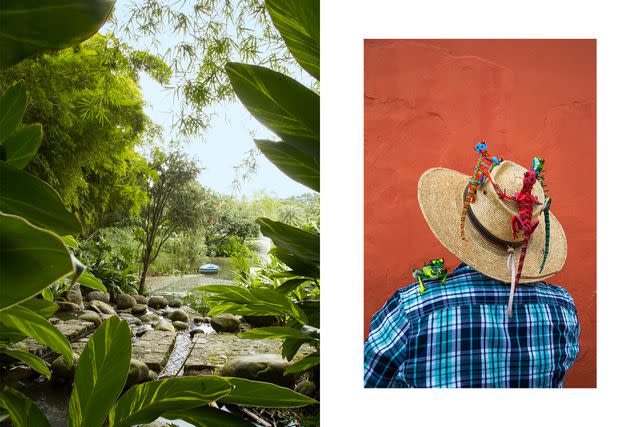
Joaquin Trujillo
From left: Villa Bokéh's gardens; a craft vendor in Antigua.We expected the climb to be strenuous, but it was just the kind of endurance challenge Erin and I like to seek out while traveling. Even so, years of hiking hadn’t prepared either of us for this trail, which rose up and up at a barbaric pitch, disappearing into the clouds with no turns to temper the incline. With each step forward, our feet sank into scree so loose that we slid backward a few inches — a sensation less like hiking up a mountain and more like running in place, in quicksand. Within minutes, I was panting. Within an hour, the question of why we thought this was a good idea had given way to a more troubling one: Were we actually going to make it?
"Nearly half of Guatemala's 18 million inhabitants identify as Indigenous, their customs meshing with Roman Catholicism to form a distinctive cultural backdrop to everyday life. "
Guatemala is known to appeal to visitors with a taste for adventure, be it backpackers drawn to its otherworldly landscapes, antiquity enthusiasts attracted to its Mayan ruins, or anyone for whom the proximity to volcanoes — the country is home to 37 — triggers a thirst for the primordial. In the context of our trip, however, hiking Acatenango was something of an outlier, a rugged capstone to an indulgent, enlightening week spent between Lake Atitlán to the west and Antigua to the east. While both have long been mainstays for travelers, today they provide a window into how Guatemala — a nation of arresting complexity and contrasts — is eager to be embraced not only for its extremes but also for an idle, earthy decadence all its own.
The Drive from Guatemala City to Lake Atitlán had reminded me of my visit eight years earlier. I remembered how the country instantly envelops you, blurring boundaries between past and present and making wherever you came from feel suddenly very far away. Once the cradle of Mayan civilization, Guatemala was later annexed by Spain and Mexico. Nearly half of its 18 million inhabitants identify as Indigenous, their customs meshing with Roman Catholicism to form a distinctive cultural backdrop to everyday life.
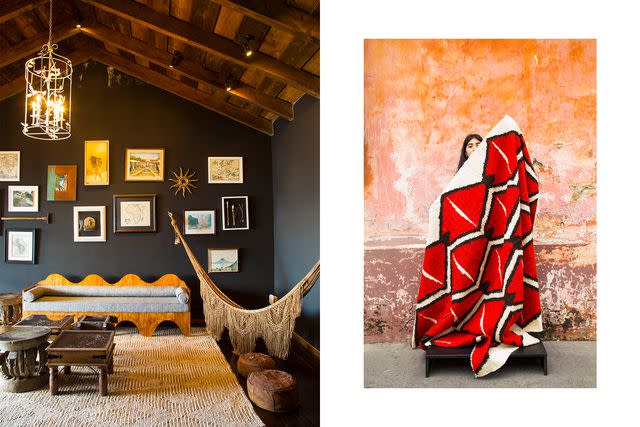
Joaquin Trujillo
From left: A suite at Casa Palopó, which showcases works by contemporary and Indigenous Guatemalan artists; Reyna Amairani with a rug from Que Onda Vos, the boutique where she works.As congested streets gave way to lush rural vistas, we navigated curving highways teeming with pickups bearing baroque chrome grilles and sputtering motorbikes with women in traditional Mayan clothing riding sidesaddle on the back. After a series of hair-raising switchbacks, we arrived at the lake. Ringed by three volcanoes, and more than 1,000 feet deep in sections, it’s a place where you could be forgiven for believing the big bang occurred just moments before your arrival. We came to a stop at Casa Palopó, a hotel where I’d spent a brief but memorable few hours on my last trip. Once an elegant, stucco-walled residence — with six rooms added in 2017, plus an additional villa up on a hillside — the place feels like an anomaly in a country where the bulk of the accommodations cater to backpackers and tour groups. The following morning we took a small boat across the lake to San Juan La Laguna, one of the many Mayan villages that dot the shoreline. From the water the hamlets have the appearance of confetti tossed into the jungle — a stark contrast to the lavish estates we had seen while driving around.
Related: Travel + Leisure Readers' 10 Favorite Cities in Central and South America of 2023
Such disparities are disconcerting but not uncommon in a country where poverty is endemic and where deep inequities led to a brutal civil war from 1960 to 1996. These tensions remain palpable and, we learned, are fueling an exodus of Guatemalan citizens. But we also began to understand the frustration, expressed by many during our stay, that the nation has been miscast in the popular imagination — that too few people recognize the richness of its culture and the breadth of activities, to say nothing of the inviting spirit you encounter wherever you go.
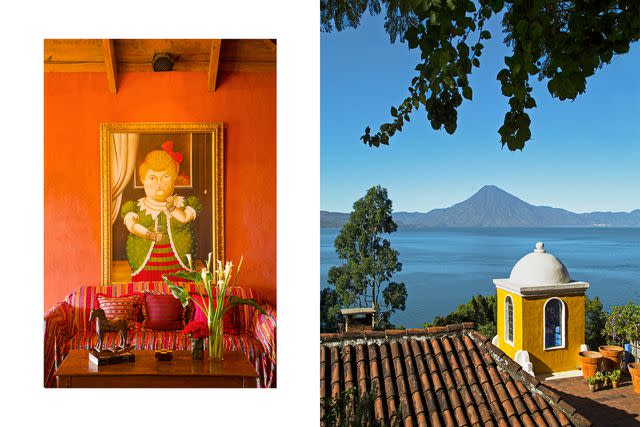
Joaquin Trujillo
From left: Woman with a Red Bow, by Colombian painter Fernando Botero, at Casa Palopó, a hotel overlooking Lake Atitlán, in Guatemala; the Atitlán volcano, as seen from the property.San Juan La Laguna was a hive of activity when we docked: meat simmering on makeshift grills in unpaved alleys; women in ornate huipils balancing bales of firewood on their heads and backs; young men hawking homemade candies from burlap sacks. The main thoroughfare, where cacao beans were the principal currency until the mid 1500s, was lined with galleries showcasing regional art. Café San Juan appeared to be merely a rustic coffee shop, but the storefront gave way to a small farm that offered a tactile education in coffee cultivation: small plants in various stages of bloom, beans being picked, dried in the sun, and finally roasted and bagged. It was a cornerstone of the country’s economy in miniature — and a refreshing reminder that, even today, authenticity is more than just a marketing concept.
Farther up the street, after a stop at a store specializing in medicinal plants, we entered the Codeas Women’s Weaving Cooperative, where the intricate textiles on sale had been made by local Mayan women. One of them gave us an impromptu tutorial in how the cotton is picked, pulled, and dyed using the region’s natural resources: a smoky brown came from avocado bark, a fluorescent green from rosemary leaves, a rich crimson from crushed roly-poly bugs.
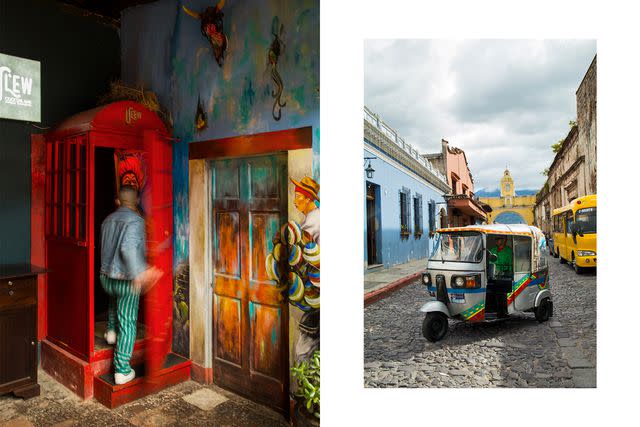
Joaquin Trujillo
From left: The cocktail bar Ulew, where the entrance is concealed in a telephone booth; a tuk-tuk in Antigua Guatemala.Soon we were back on the boat, crossing the lake for lunch in San Marcos, a hippie stronghold since the 1970s that has more recently cast a spell over urbane wellness disciples and the ayahuasca-curious. We scuttled up a steep road in a tuk-tuk, dodging chickens and stray dogs before coming to a dead end at a wall of vegetation. It was hard to imagine anything new sprouting up along the well-worn paths, yet a quarter-mile in, we came across La Casa Zapote.
With its exterior of unpainted cinder block and exposed rebar, the hotel looked as if it was still under construction, but when we stepped over the threshold we discovered a column-ringed courtyard containing an Italian restaurant, El Artesano. Made up of a smattering of rustic outdoor tables and shaded by a corrugated metal roof, it specializes in boards of cheeses and meats cured by the chef, Dietrich Gantenbein, a Guatemalan of Swiss ancestry who is a longtime fixture of the area. Sipping a Chilean Cabernet Sauvignon, we grazed and lost track of time. We returned to the hotel as day gave way to dusk.
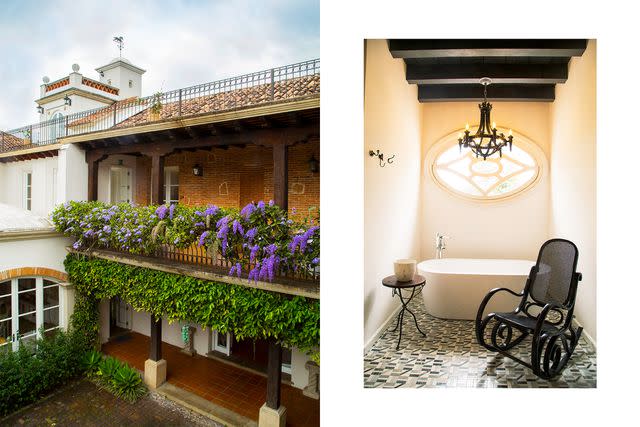
Joaquin Trujillo
From left: The courtyard of Villa Bokéh, a hotel in Antigua Guatemala; the bathroom in a Villa Bokéh suite.These leisurely, unexpected moments provided one of the greatest revelations on this visit to Guatemala. On my previous trip, I was constantly flitting from one sight or activity to the next, as tends to be the case for many people. Stimulating as that type of travel can be, this time around I realized just how much of the country’s allure comes from a mystical, almost gravitational force that is best appreciated by slowing down, lingering, and surrendering to whatever moment you find yourself in. After our three days at Casa Palopó, each capped by a hallucinatory sunset, Erin and I felt a giddiness that would only deepen and expand over the next few days.
Related: The Best Resorts in Central America
Founded in the early 16th century, Antigua served as Guatemala’s capital for nearly 250 years. In 1773, after many earthquakes, floods, and volcanic eruptions, the Spanish relocated to what is now Guatemala City. In 1979, Antigua was recognized as a unesco World Heritage site. Much of its draw is the transporting sense that little has changed since the Spanish left town: the ornate Baroque architecture, the manicured public squares, the labyrinthine markets you can get lost in for hours — all rising from the same inviting, elegant grid.
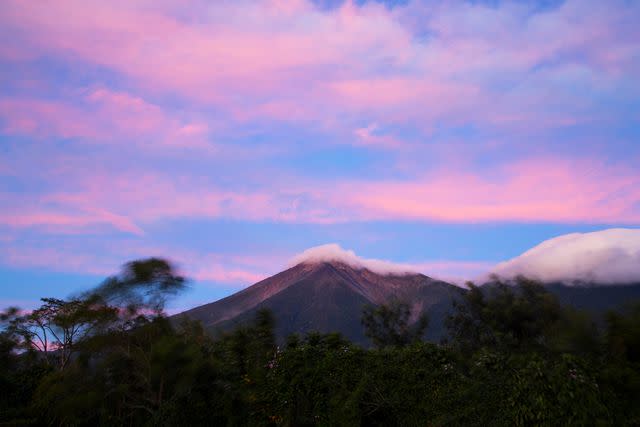
Joaquin Trujillo
The Fuego volcano at sunset.We were staying at Villa Bokéh, a stylish property that opened on the outskirts of town in 2021. It is a world of refinement at the end of a long driveway shaded by jade vine. Hidden behind a hulking wooden door stands the main hacienda, an estate of whitewashed grandeur that looks out onto a tranquil pond. In the near distance I spotted Volcán de Agua, the volcano that looms over the city.
Villa Bokéh was built as a family home by an American photographer, Mitchell Denburg, who lived there with his Guatemalan wife, the photographer and artist Lissie Habie. During the pandemic, it was painstakingly converted into a hotel by Grupo Alta, the same local hospitality company that has been operating Casa Palopó since 2010. The week before Erin and I arrived, the last of its 15 rooms had been completed—each a unique, textural riff on the country’s heritage.
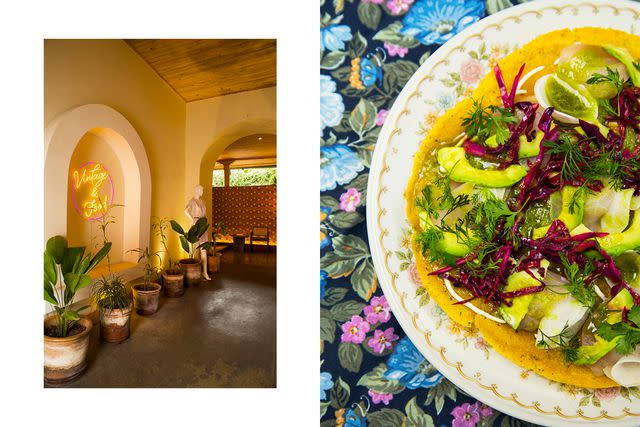
Joaquin Trujillo
From left: Nana, a restaurant and vintage clothing boutique in Antigua Guatemala; Nana's tlayuda, made with snapper and roasted purple cabbage.Once settled in our airy suite on the upper floor, I met Grupo Alta’s president Claudia Bosch in one of the main rooms off the extensive patio. Sipping an aperitif, the hotelier, who was born and raised in Guatemala City, made it clear that she saw her properties not simply as luxurious places to stay, but as a way to shift how Guatemala is perceived.
“Tell someone you’re going to Mexico or Costa Rica and they’ll tell you places to stay, places to see, but tell someone you’re going to Guatemala and the first thing people say is to be safe,” she lamented, shaking her head. Though Bosch expects this reaction, as drug-cartel-related crime still plagues parts of Guatemala’s far west, she expressed irritation at just how much of the country remains misunderstood. “We’re known as this hidden gem,” she went on. “But, frankly, we are tired of being ‘hidden.’ ”
Related: 8 Important Craft Traditions From Around the World
This sentiment can feel like the unofficial motto of Antigua, a city that, for all its antiquity, is hardly suspended in amber. That evening, Erin and I wandered down streets lined with stately buildings, eventually finding ourselves in the minimalist dining room at Quiltro.
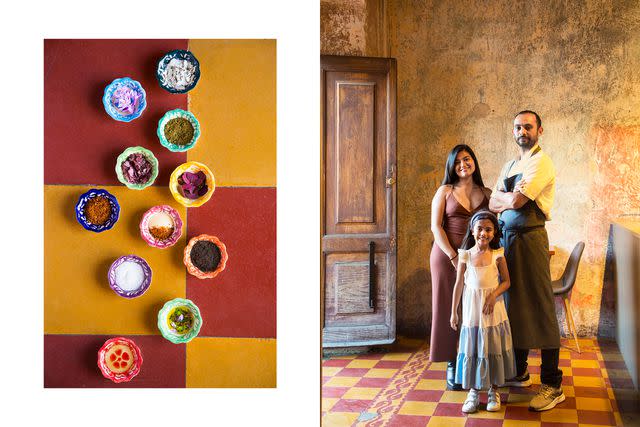
Joaquin Trujillo
From left: Dishes filled with hibiscus flower and other local ingredients at Quiltro, a restaurant in Antigua Guatemala; chef Rodrigo Salvo of Quiltro, with his wife, Dulce Maria Palacio, and daughter, Camila.Rodrigo Salvo, Quiltro’s lanky, genial chef, came by our table at the start of the meal. The restaurant, he explained, was an extension of his personal love affair with Guatemala. Originally from Chile, he settled in Antigua after traveling the world and doing a stint at Noma, Copenhagen’s temple to foraging. “Aside from having a perfect climate, in Guatemala there is a slow, artisanal process to everything in life,” he said. “That’s what pulled me here.”
What followed was a 12-course feast of striking small plates: pickled mango flecked with black salt, sea bass with chicharrones made of crispy fish skin, cauliflower resting in a pool of milk rendered from caramelized cauliflower. Where such meals in bigger cities can quickly feel pretentious, this experience was marked by an infectious earnest-ness. At one point, Erin, a lover of food but an opponent of modern gastronomic flourishes, found herself choked up between bites. “It sounds crazy,” she said, “but it’s like you can actually taste how much this means to him.”
Much of the country’s allure comes from a mystical, almost gravitational force that is best appreciated by slowing down.
"
"
Food like this is no longer the exception in Antigua, where other young chefs are carving out a niche that feels very distinct from the backpacker cafés and stuffy white-tablecloth establishments that have long dominated. The following day — after visiting boutiques like Que Onda Vos, which sells home goods designed by Belgian owner Hanne De Wyngaert and made by Guatemalan artisans — we stopped for lunch at Nana. The restaurant and vintage clothing shop, which opened during the pandemic, is unapologetically hip, with mid-century cane-backed chairs and a sleek bar shaded by dangling ferns that contrasted with the rustic interior courtyard. The food and drink were a far cry from the meals I recalled from my previous trip: red-snapper crudo with pickled beets and a miso crumble, sourdough baked in-house and served with a hummus of fresh peas, an exquisite rum sour with the faintest hint of wasabi.
“I’m not sure this would have worked five years ago,” said Rodrigo Aguilar, Nana’s chef and owner. His first restaurant was Kombu, a ramen spot priced to appeal to backpackers. But having cut his teeth at New York’s WD-40, Aguilar wanted to bring some of that culinary juju back to his native country. The pandemic allowed him and his wife, Sharon Aza?on, who operates the vintage boutique, to conceive of Nana from a different angle. “Rather than thinking of what other people want, be it tourists or wealthy people from Guatemala City coming in for the weekend, we had time to think about where we wanted to go,” he explained. “Nana is essentially that — we do our thing and invite you in, which hasn’t been the way hospitality has tended to be approached in this country.”
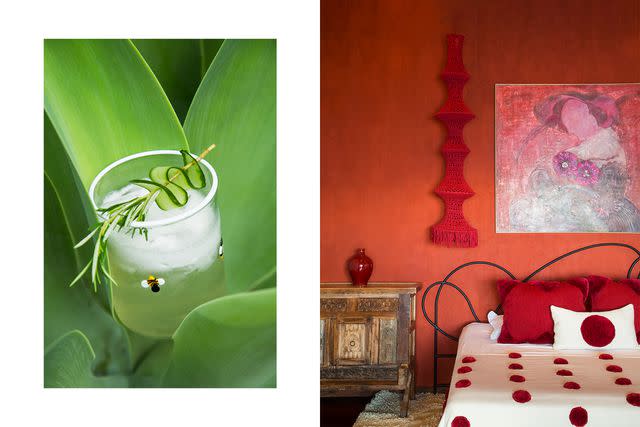
Joaquin Trujillo
From left: The Paloma cocktail at Villa Bokéh; the bedroom of the Cerro de Oro Suite at Casa Palopó.As we spoke, I couldn’t help noticing one of Aguilar’s tattoos: a landscape covering his forearm, which turned out to be the view from the summit of Tajumulco, the tallest volcano in Guatemala. Despite being surrounded by volcanoes everywhere we went, in our languorous stupor I’d forgotten that, the following morning, Erin and I were set to depart for Acatenango, which was just a few miles from where we stood. I mentioned this to Aguilar and asked if he had any words of advice.
“Oh, man, there’s nothing like it,” he said, a wily glint in his eye. “But let me tell you: it is going to be very, very hard.”
At about the exact moment when I was so exhausted on our hike that I wasn’t thinking about turning back so much as going slack and rolling back down, something happened: the landscape around us underwent a swift, dramatic change, as it does so often in Guatemala. The punishing expanse we’d crossed that morning morphed into a cloud forest of gargantuan ferns and moss-choked trees. The incline remained brutal, but the damp ground, and the solid footing it offered, changed the entire experience.
More Trip Ideas: Alaska Airlines Is Adding New Routes to Central America, Mexico for Winter — What to Know
“That first section is the killer,” noted our guide, Mario Ramirez, as we took in a view that now extended to the Pacific coastline. “The rest will be maybe not easy, but possible.”
A nimble man who radiates positive energy, Ramirez works with Trek Guatemala, in addition to giving his own group and private tours of Acatenango. His expertise showed in the routes he chose, which kept us separated from other hiking groups and gave us the beguiling sense of having the volcano to ourselves.
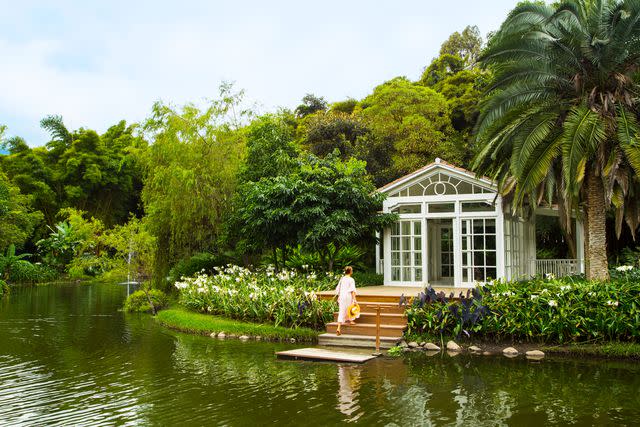
Joaquin Trujillo
The greenhouse at Villa Bokéh.Some five hours of uphill later, we arrived at the campsite. The cloud forest had yielded to a mist-shrouded landscape of towering pines.
“And now,” Ramirez said, “the show begins.”
The thin air carried a chill as clouds swirled around us — and, dizzyingly, below us — at time-lapse speeds. Soon the sun began to set and the sky cleared, revealing our neighbor, Fuego — its triangular peak black against a purple-orange backdrop. While Ramirez got a fire going and cooked up a meal of stir-fried vegetables, Erin and I watched as Fuego erupted about every 15 minutes. Each explosion was preceded by a primeval gurgle that gave way to bursts of lava.
Come dawn the next morning, we would climb to the summit, which would be grueling. And the descent back to the city would present a formidable challenge to our thighs, our knees, and our egos. But just then we were content to marvel at the volcano’s ferocious splendor, framed by a canopy of glittering stars.
The Charms of Antigua Guatemala
Where to Stay
Casa Palopó: This luxurious property’s hillside location provides uninterrupted views of Lake Atitlán. The hotel can arrange outings to lakeside villages, healing sessions with a local shaman, a visit to a weaving collective, and other experiences.
Villa Bokéh: A mansion at the edge of Antigua’s old town houses a new hotel from the team behind Casa Palopó. It has 15 character-filled rooms, an excellent restaurant, and lavish grounds.
Where to Eat
El Artesano: Guatemalan-Swiss chef Dietrich Gantenbein cures all of the meats at his Italian restaurant, located inside La Casa Zapote hotel just outside San Marcos, a hippie enclave on Lake Atitlán.
Nana: A restaurant and shop selling jeans, boots, and other vintage items, Nana has introduced a casually hip sensibility to Antigua’s dining scene.
Quiltro: Chef Rodrigo Salvo’s training at Noma and his deep affinity for Guatemalan culture shine in his restaurant, which opened in 2021.
Ulew: At this bar inside a brewery — find it through a secret door built into an old phone booth — bartenders use local herbs and liquors to craft exquisite cocktails.
Where to Shop
Codeas Women’s Weaving Cooperative: Textiles made and sold by members of the Mayan community. Calle Chi Nima Ya, San Juan La Laguna.
Mercado de Artesanías: Wonderfully cluttered and chaotic, this is the place to roam through dozens of stalls and barter for blankets, wooden spoons, and other handicrafts. 4a Calle Poniente, Antigua Guatemala.
Que Onda Vos: Locally made rugs, glassware, and art, showcased in an airy, whitewashed space.
How to Book
Trek Guatemala: This Antigua-based outfitter specializes in one-of-a-kind adventure tours, including overnight hikes to the peak of Acatenango and a multiday glamping expedition from Antigua to Lake Atitlán.
A version of this story first appeared in the August 2023 issue of Travel + Leisure under the headline "Surprise and Delight."
For more Travel & Leisure news, make sure to sign up for our newsletter!
Read the original article on Travel & Leisure.